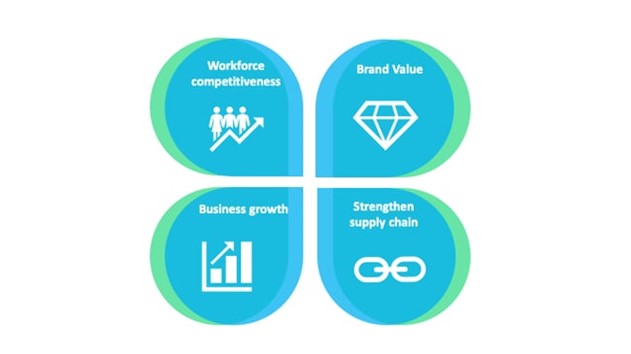Social Innovation: How can it contribute to sustainability in manufacturing?
What is it in practise?
As we learned in the first article on Social Innovation on the greenSME hub, social innovation in companies can be used both as a process to reach a goal, and as solution in itself.
For manufacturing, there are several angels and possibilities to use social innovation to reach a goal (process), and to solve specific issues (solution). Some general examples given
- Creating strategic partnerships & engagement of business partners
- Involvement and engagement of employees in strategic/organizational/technical development processes
- Training & development of employees (e.g. in human-technology relation)
- Development and review of social & sustainable business models
More concrete examples can be establishing a cross-organisational innovation hub to be a part of both strategic and technological development of a company, or develop training programs for staff when deploying new technology. To secure sustainable processes and innovation, it is important to relate the social innovation initiatives with core business objectives and activities so that the financial value and initiative remains.

What are the key principles and business benefits?
Diana Porumboiu from Viima solutions, A hype innovation company, has in an article (2021) formulated 3 key principles for Social Innovation initiatives to be successful in companies:
Strategic intent: Corporate social innovation initiatives cannot stand alone – it needs to be incorporated into the business strategy and strongly supported by top management and the vision of the company.
Leveraging markets: social innovation initiatives can open new perspectives and innovations, which can lead to new market opportunities and strategies.
Strategic collaborations: the inclusion of external partners and stakeholders in innovation processes often contributes to successful solutions – both for wider acceptance of innovations, and for stronger ownership and commitment to innovations.
Further in the article on social innovation in corporations, Porumboiu specifies four direct business benefits of corporate social innovation that contributes to financial sustainability of a company, see table and summaries as follows.

1. Workforce competitiveness
More and more employees are valuing work with a role of purpose. Work dedication and engagement is getting closer related to empowerment and development, something companies practicing social innovation and engagement is fostering. To create the space to co-develop and innovate is attracting the younger generations and is only getting more important for companies to address in order to stay competitive on the workforce market.
2. Business growth
For companies to focus on environmental and social issues is not only good for society but also business. The vast opportunities in new markets, customers and products are waiting for new innovative solutions. Here, it is not only technological innovation that can make a difference and develop new business opportunities – social innovation and solutions can be key to the next company direction and new income.
3. Strengthend supply chain
Including the supply chain stakeholders in innovation and development processes can generate both social and financial gains. It can secure closer relations, and both ensure more robust and sustainable material access and improved responsiveness to consumer needs and market fluctuations.
4. Brand value
It is no longer possible to ignore that the customer expectations on companies and products is growing. People are favoring companies with values and beliefs close to their own, and who is taking action to improve social and environmental issues. It is up to each company to work with this and find the right issues to address where it is still financially viable.

Contribution to green & social sustainability
By introducing inclusive and engaging processes for employees and/or stakeholders within companies, you empower the people, their feeling of value, contribution and wellbeing in their jobs. You also increase the opportunity to develop innovations contributing to social and societal impact outside of the company.
Social innovation is often combined with other aspects such as technology deployment or other environmental projects. By combining the social innovation process with these activities, you have the opportunity to strengthen the results and final impact by a strong engagement and ownership by employees and stakeholder. In other words, any green or environmental goal the company sets, the results and impact can become larger if social innovation processes have been part of the development phase.
In the next article of the social innovation series, you will learn about how to get started with social innovation in your company!
References
Porumboiu Diana, Social Innovation – the What, Why and How (2021). Online article on https://www.viima.com/blog/social-innovation



